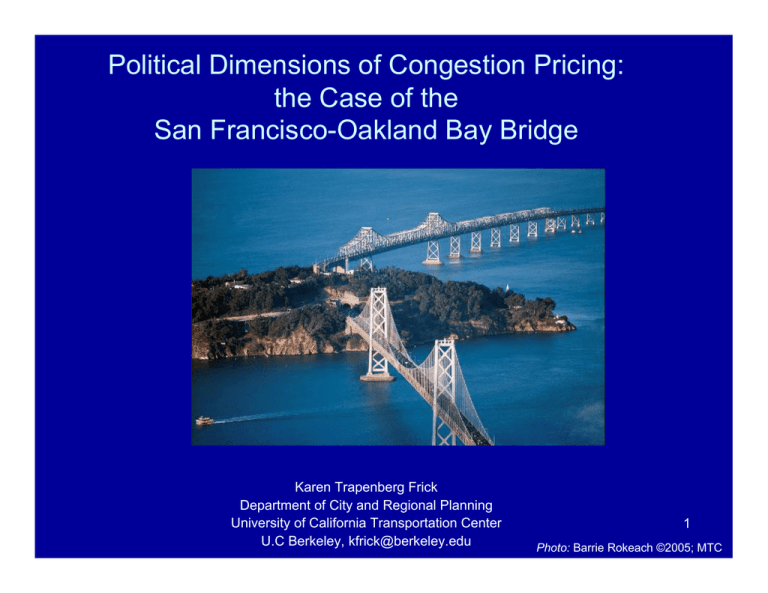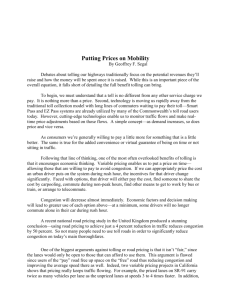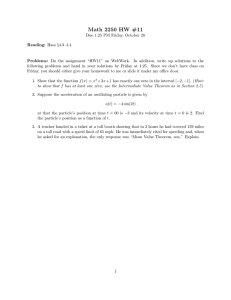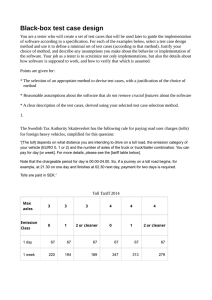Political Dimensions of Congestion Pricing: the Case of the
advertisement

Political Dimensions of Congestion Pricing: the Case of the San Francisco-Oakland Bay Bridge Karen Trapenberg Frick Department of City and Regional Planning University of California Transportation Center U.C Berkeley, kfrick@berkeley.edu 1 Photo: Barrie Rokeach ©2005; MTC Roadmap • Context setting • First, the not so good news Bay Bridge effort • Second, the better news Overcoming challenges & political hurdles if the timing is right And a thank you to NEXTOR and Professor Mark Hansen 2 Non-Road Examples • Airline tickets: peak seasons, time-of-day • Matinee movie tickets • Telephone use: business hours vs. evenings/weekends (esp. cell calls) 3 A student favorite example! 4 Should freeways be “free-of-charge”? Congestion Pricing Types: one size does not fit all ¾Existing versus new ¾All lanes (toll bridge, toll road) ¾high-occupancy toll lanes (HOT) lanes ¾Area-based (London) 6 Relevance of Bay Bridge Case • A new frontier – goal of reducing delay plus others • No pricing projects in US to point to then • None on existing facility • Significant congestion (20 minutes delays) • Geographically constrained--where expand capacity? new bridge would be costly & major environmental issues • Equity & political consequences… 7 • First federal project selected in U.S. • Funded through federal Congestion Pricing grant (program now called “Value Pricing”) • Test case for federal grant process, agreements, guidance 8 Key Partners • Metropolitan Transportation Commission • State Dept of Transportation (Caltrans) • Business and environmental groups— Important combination • Federal Highway Administration (FHWA) 9 • Need state legislative authorization to increase toll because bridge is a state facility • Toll was $1, carpools (3+ occupants) free • Examined $2 to $5 peak toll, both directions with $ to travel alternatives 10 • Many preconceptions in bridge case • For airports, preconceptions? historic issues? 11 Preconception #1 • Bridge already paid for • Tolls should be removed • Pricing as “double taxation” – regular toll and the peak surcharge??? – What about the gas tax? 12 Source: MTC 13 Preconception #2 • Everyone in corridor would pay more 14 Source: MTC 15 Preconception #3 • Higher tolls will hurt low income drivers • Isn’t that the main equity issue? • Key issue for elected officials—wanted a clear solution to this problem 16 Source: MTC 17 Also equity issues — not just income related • Individual equity: – impact on poor – “car-dependents” (for work, travel during peaks because of childcare, inflexible work schedules), and/or do not have commute alternatives • Geographic equity: East vs. West Bay • Modal equity: $ distribution between transit agencies, carpool, bicycle 18 Preconception #4 • Drivers will not want to pay a higher toll 19 http://www.transcoalition.org/reports/wct/i/busidiot.jpg 20 Photograph by Sarah Leen, National Geographic 21 Preconceptions gathered through: – focus groups – stakeholder interviews – media accounts 22 Five major concerns voiced 1. need visible delay reduction 2. toll could not be too high 3. But…skeptical about reducing delay unless very high toll 4. need visible transit improvements 5. skeptical on government spending new dollars wisely and delivering promised projects 23 The Proposal--“package approach” • $3 peak toll, morning and evening • Carpools remain toll-free • $23 million generated to fund transit, rideshare, bicycle improvements • “Lifeline” toll via electronic toll collection 24 Source: MTC 25 “SHOW ME THE MONEY” Source: MTC 26 Lifeline Toll Component • Eligible low-income drivers would remain at $1 • Modeled after Pacific Gas & Electric’s program • 1,780 eligible households estimated out of 56,260 (3%) • A $3 peak toll = $22.5 million annually • lifeline toll “cost” = $1.5 million http://www.680smartlane.org/virthouse.html 27 Timing, Timing, Timing • November 1994 election, state and federal • Revenue Neutrality pitched: – off-peak discounts – “shoppers special” • From inception, recommended citizens oversight committee 28 http://www.veryfunnypics.com/cartoons/trans/page/8.htm And now the funding crisis… 29 With a funding crisis, pricing viewed as a potential solution 30 SF Chronicle, 7/22/04 31 SF Examiner, 7/18/97 32 Flat toll increase prevailed to fund new bridge Source: MTC/Caltrans 33 Existing and New Spans Existing Bridge Existing span photograph: Barrie Rokeach ©2005; MTC new bridge simulation: MTC/Caltrans New East Span (simulation) 34 Bay Bridge Lessons Learned • Revenue Implications, federal pilot program • Equity is multi-faceted—need visible projects to address • Timing, timing, timing • Partnerships / local champions • Patience, Flexibility, & Perseverance (also, on-going monitoring & evaluation, transparency, accountability) 35 Lessons are good… but from the bridge effort & others what can we do? “the better news” 36 Action Item #1 Marketing & Project Positioning 9Public & media involvement early! 9Clear, visible benefits 9Provide choice (to pay or not pay toll?) or off peak discount? 9reliability 9easier to market new/expanded facilities (ex: new HOT lanes) 37 Seeing is believing! Above: http://www.ops.fhwa.dot.gov/publications/congestionpricing/congestionpricing.pdf; Below: SR91 Annual Report, FY 2005 38 For a commercial of SR 91 in California, see http://www.91expresslanes.com/virtdrive.html State Route 91; http://www.91expresslanes.com/ 39 “…customers estimated shaving nearly 30 minutes off their morning and afternoon drives, even during rush hour. That’s enough time to catch a child’s soccer game, stop at a grocery store before dinner or simply enjoy more time relaxing at home” Orange County Transportation Authority SR91 Annual Report, FY 2005, p.4 40 “HOT lanes really are a form of ‘congestion insurance’ for any traveler willing to pay the toll – whether it is a businessperson late for a meeting or a parent racing to pick up a child at day care” Metropolitan Transportation Commission http://www.mtc.ca.gov/planning/hov/faq.htm 41 Action Item #2 Consider toll setting via a performance measure • San Diego and in CA future HOT lanes: – Price varies to maintain a certain level of service – Shifts toll setting from public officials to (Shoup, 2005) drivers! 42 Action Item #3 Visible Benefits of New Revenues Consider whether off-peak discounts and revenue neutrality needed Where does the $ go? New infrastructure, transit, other Recent paper looks at not investing in transit/transp. necessarily (King & Shoup) 43 Action Item #4 Pilot Tests & Sunset Provisions To find out “real world” impacts & if preconceptions about equity, other sticking points come to pass Demo funding assistance? Transparency, oversight & accountability 44 When is pricing implemented on roads? • benefits are clear & defined • Clarity on use of funds • local area perceives a crisis in terms of – congestion – Needing additional funds – Increasing use of an underutilized facility, such as an HOV lane • diverse constituency in support; strong local champions (policy entrepreneurs) 45 Is Pricing Worth the Price-Your thoughts? Vacaville Reporter, 12/22/94 Karen Trapenberg Frick U.C. Berkeley kfrick@berkeley.edu 46



